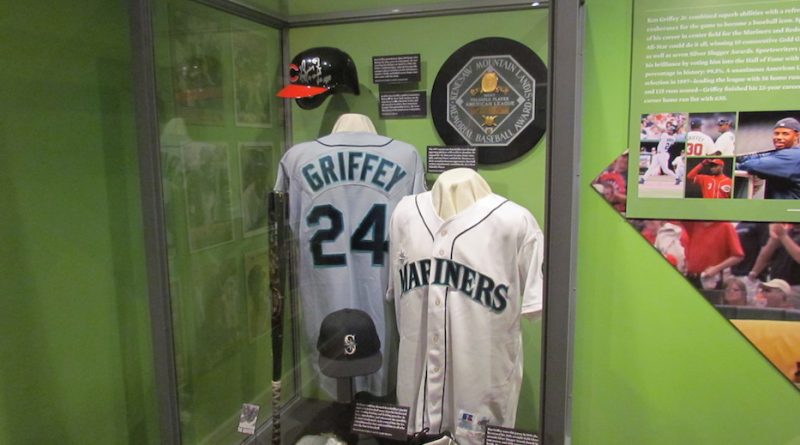Hall Ball: Unearthing America’s pastime in Cooperstown
By: Steve Miller—Sports Editor
Nestled snuggly in the mountains between Albany and Syracuse, barely removed from Amish country, lies Cooperstown, NY—a village on a lake, but a city on a hill to the baseball world. In what I can best describe as a mysterious baseball utopia, Cooperstown enshrines the game’s history, freezing moments in time from the 1800s to present day.
I visited Cooperstown for the first time in my life in early August to take in the cornucopia of knowledge and history of America’s pastime.
At 25 Main Street, the Hall of Fame and Museum itself does not stick out greatly among the baseball-related shops and restaurants lining Cooperstown’s center drag, but its influence is impossible to ignore. Aside from a general store and a post office, every door on Main Street is an entrance to a baseball-themed experience—be it the wax museum, the memorabilia stores, or restaurants named to honor legends of the game.
Inside the Hall, three floors preserve the game’s history in relics and displays. The Plaque Gallery, located on the first floor, is the main attraction of the Hall of Fame. In it are modest plaques commemorating the players, managers and servants of the game of baseball who have been formally inducted into the Hall.
The 2016 class of inductees featured Cincinnati’s own outfielder Ken Griffey Jr. and longtime New York Mets and Los Angeles Dodgers catcher Mike Piazza. Artifacts from Griffey’s and Piazza’s careers are encased, for the time being, just outside the Plaque Gallery, presumably until the new members of next year’s class are inducted.
Griffey and Piazza are a fascinating duo to be elected in the same year because they, respectively, are the highest and lowest draft picks to ever be inducted into the Hall of Fame.
Griffey, the first overall pick in the 1987 draft, is the first top selection to also be inducted. Piazza was selected in the 62nd round of the 1988 MLB draft and was the 1,390th overall pick.
Griffey also set a record for garnering the highest percentage of the induction vote. This year, 440 members of the Baseball Writers Association of America voted, with 437 favoring Griffey’s induction—a 99.3 percent mark. Piazza was elected with 83 percent of the vote. In order to be inducted, a player must be selected by 75 percent of the voting members.
Beyond the Plaque Gallery on the first floor sits “Scribes and Mikemen,” an exhibit honoring the history of writing and broadcasting in the game. Then, “Baseball at the Movies” features costumes and props from beloved baseball movies such as Field of Dreams, The Rookie and The Sandlot.
Just up the stairs on the second floor is a room designed like a baseball clubhouse, with one locker devoted to each Major League team. In each glass-enclosed locker are uniform and equipment items from important moments in each team’s recent history.
I found this room to be the most captivating because it appeals to the person who has watched SportsCenter in the last decade rather than the person who has intently studied the early history of baseball. Important artifacts like Miguel Cabrera’s cleats from his Triple Crown securing game in 2012 and the ball from Stephen Strasburg’s first ever recorded out were on display. These are moments of baseball history etched in my mind since I witnessed them as they happened.
A quick transition from the game’s lively present to its storied past sits just outside the clubhouse in the Babe Ruth room. All things Great Bambino are chronicled from his troubled childhood in Baltimore, Maryland, to his early death from cancer in 1948. His full uniform is on display along with other miscellaneous artifacts from Ruth’s career.
Perhaps the single most intriguing piece of history in the museum is Barry Bonds’ 756th home run ball, which is encased in a small exhibit detailing the ominous cloud of steroids over the game in the 1990s and early 2000s. The home run ball, with which Bonds broke Hank Aaron’s all-time record of home runs in 2007, was donated by a private owner who cut an asterisk into its hide before gifting it.
The asterisk, which is used to denote exceptions or footnotes in record books, is commonly used when referring to a statistic influenced by the steroid age in baseball. Although Bonds was never formally disciplined by Major League Baseball for steroid usage, it is widely believed that he used performance-enhancing drugs.
More exhibits dive into other niches of baseball, like the rise of Latino players in the Major Leagues, the revolutionized ballpark architecture of the 1990s and 2000s and the most famous records of baseball history.
I spent about six hours inside the museum between two days in Cooperstown, and I did not even come close to reading every word on display.
Beyond the bricks of the Hall of Fame lie memorabilia stores beckoning with apparel, autographs and souvenirs from every team in the Major Leagues.
And if you hear the crack of a bat on Main Street, a quick jaunt over to Doubleday Field will allow you to witness the only live baseball in Cooperstown, where teams and camps regularly use the park for games.
Climbing out of the rabbit hole of the game’s wonderland is as quick as diving into it. And the surroundings of upstate New York show little traces of baseball’s Mecca, which awaits with stories and secrets for the next curious soul.



